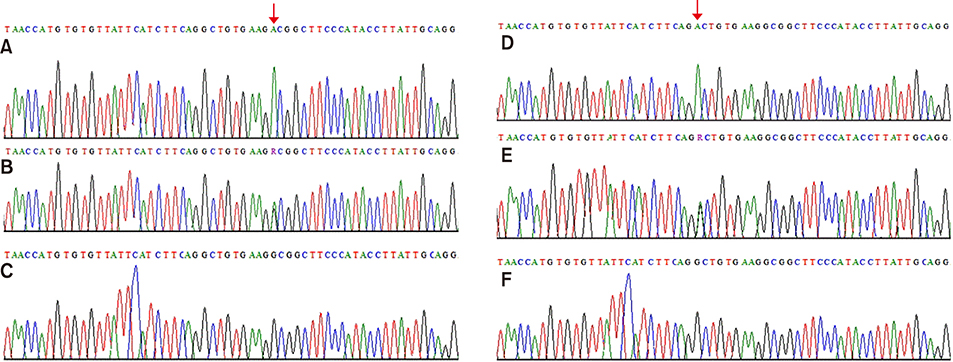Ann Dermatol.
2020 Feb;32(1):77-80. 10.5021/ad.2020.32.1.77.
Missense Mutations in the CTSC Gene in Saudi Families Segregating Papillon-Lefèvre Syndrome
- Affiliations
-
- 1Center for Genetics and Inherited Diseases, Taibah University, Almadinah Almunawwarah, Saudi Arabia. sbasit.phd@gmail.com
- 2Department of Genetic Diseases, King Abdulla Medical City-Madinah Maternity and Children Hospital, Almadinah Almunawwarah, Saudi Arabia.
- 3Department of Biology, College of Science, Taibah University, Almadinah Almunawwarah, Saudi Arabia.
- 4Department of Genetics, King Faisal Specialist Hospital and Research Center, Riyadh, Saudi Arabia.
- KMID: 2467206
- DOI: http://doi.org/10.5021/ad.2020.32.1.77
Abstract
- No abstract available.
MeSH Terms
Figure
Reference
-
1. Alkhiary YM, Jelani M, Almramhi MM, Mohamoud HS, Al-Rehaili R, Al-Zahrani HS, et al. Whole-exome sequencing reveals a recurrent mutation in the cathepsin C gene that causes Papillon-Lefevre syndrome in a Saudi family. Saudi J Biol Sci. 2016; 23:571–576.
Article2. Haneke E. The Papillon-Lefèvre syndrome: keratosis palmoplantaris with periodontopathy. Report of a case and review of the cases in the literature. Hum Genet. 1979; 51:1–35.
Article3. Hamon Y, Legowska M, Fergelot P, Dallet-Choisy S, Newell L, Vanderlynden L, et al. Analysis of urinary cathepsin C for diagnosing Papillon-Lefèvre syndrome. FEBS J. 2016; 283:498–509.
Article4. Idon PI, Olasoji HO, Fusami MA. Papillon-lefevre syndrome: review of literature and report of three cases in the same family. Niger Postgrad Med J. 2015; 22:75–82.5. Toomes C, James J, Wood AJ, Wu CL, McCormick D, Lench N, et al. Loss-of-function mutations in the cathepsin C gene result in periodontal disease and palmoplantar keratosis. Nat Genet. 1999; 23:421–424.
Article6. Nagy N, Vályi P, Csoma Z, Sulák A, Tripolszki K, Farkas K, et al. CTSC and Papillon-Lefèvre syndrome: detection of recurrent mutations in Hungarian patients, a review of published variants and database update. Mol Genet Genomic Med. 2014; 2:217–228.
Article7. Basit S, Al-Harbi KM, Alhijji SA, Albalawi AM, Alharby E, Eldardear A, et al. CIT, a gene involved in neurogenic cytokinesis, is mutated in human primary microcephaly. Hum Genet. 2016; 135:1199–1207.
Article8. Hashmi JA, Albarry MA, Almatrafi AM, Albalawi AM, Mahmood A, Basit S. Whole exome sequencing identified a novel single base pair insertion mutation in the EYS gene in a six generation family with retinitis pigmentosa. Congenit Anom (Kyoto). 2018; 58:10–15.
Article9. Moghaddasian M, Arab H, Dadkhah E, Boostani H, Babak AR, Abbaszadegan MR. Protein modeling of cathepsin C mutations found in Papillon-Lefèvre syndrome. Gene. 2014; 538:182–187.
Article10. Turk D, JanjiXMLLink_XYZ V, Stern I, Podobnik M, Lamba D, Dahl SW, et al. Structure of human dipeptidyl peptidase I (cathepsin C): exclusion domain added to an endopeptidase framework creates the machine for activation of granular serine proteases. EMBO J. 2001; 20:6570–6582.
Article
- Full Text Links
- Actions
-
Cited
- CITED
-
- Close
- Share
- Similar articles
-
- Novel Compound Heterozygous Mutations in CTSC Gene in a Chinese Family with Papillon–Lefevre Syndrome
- A homozygous mutation in the insulin gene (INS) causing autosomal recessive neonatal diabetes in Saudi families
- Two Cases of Papillon-Lefevre Syndrome
- A Case of Familial Hemiplegic Migraine
- The Prevalence of Founder Mutations among Individuals from Families with Familial Pancreatic Cancer Syndrome



